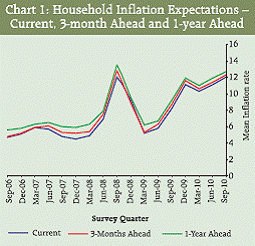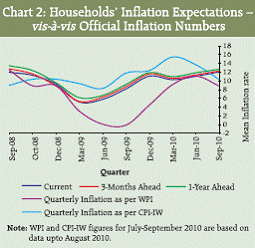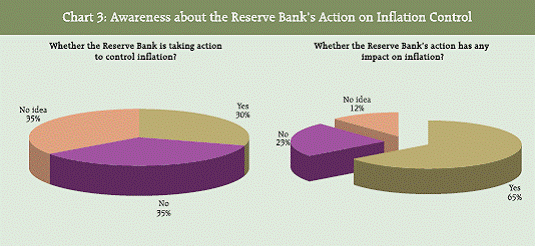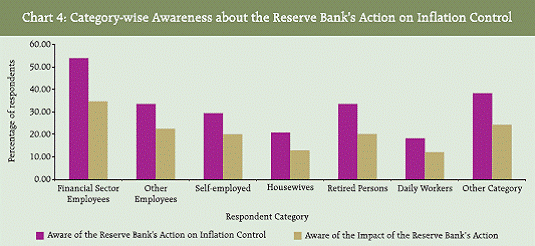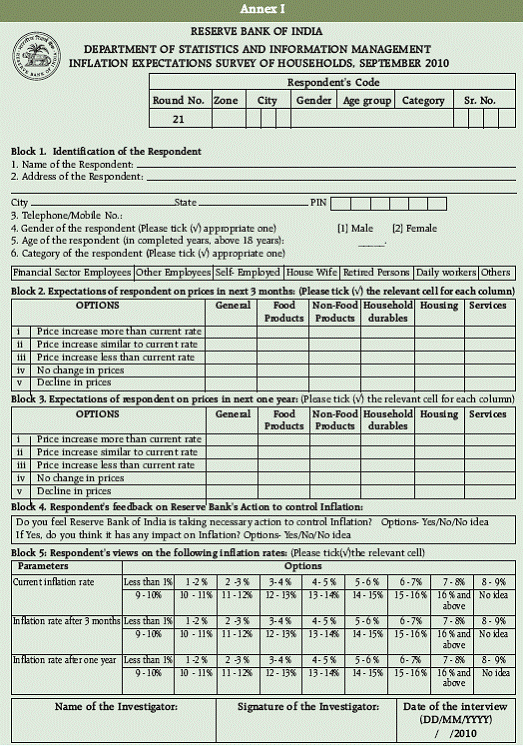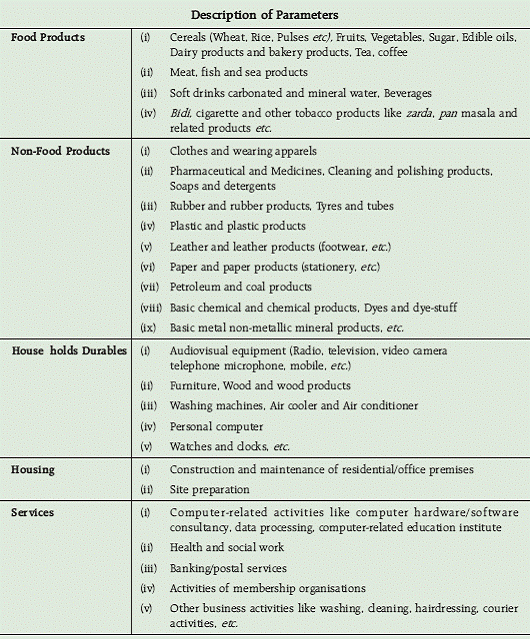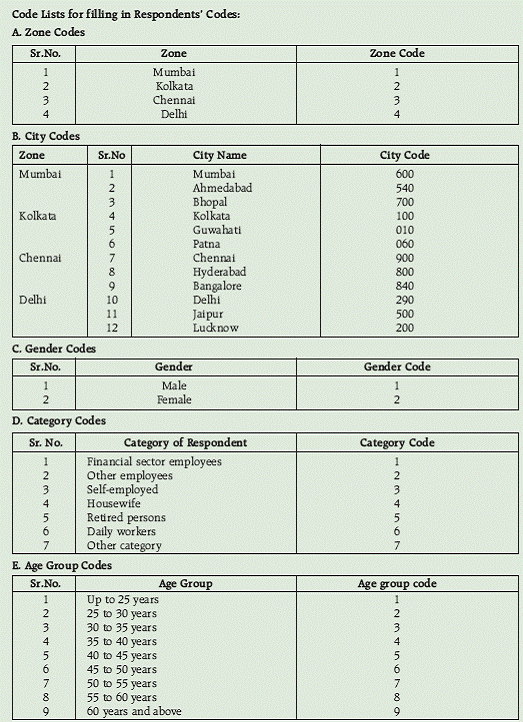Inflation Expectations Survey of Households : September 2010(21st Round)* - RBI - Reserve Bank of India
Inflation Expectations Survey of Households : September 2010(21st Round)*
This article presents the findings of Inflation Expectations Survey of Households for July–September 2010 quarter, the 21st round in the series. The survey sheds light on the inflation expectations of 4,000 households across 12 cities for the next quarter (October– December 2010) and for the next year (October 2010-September 2011). The survey captures the expectations of inflation for a respondent’s own basket of consumption. Therefore, the inflation rates from this survey represent the inflation expectations of 4,000 urban households based on their individual consumption baskets and hence these rates are not to be considered as predictors of any official measure of inflation. The households’ inflation expectations provide useful directional information on nearterm inflationary pressures and also supplement other economic indicators, to get a better indication of future inflation. The survey findings portray that households expect inflation to rise further by 20 and 60 basis points during the next one quarter (to 12.3 per cent) and the next one year (to 12.7 per cent), respectively, from the perceived current rate of 12.1 per cent. Households’ expectations of general price rise were mainly influenced by movements in prices of food products. More respondents expected price-rise in food, housing and non-food products compared to other product groups. Housewives and Daily-wage workers expected higher inflation rates compared to other categories. Higher inflation expectations persisted in Bangalore and Lucknow. Section I: Introduction The Reserve Bank of India has been conducting Inflation Expectations Survey of Households (IESH) on a quarterly basis, since September 2005. The survey seeks qualitative responses on price changes (general prices as well as prices of specific product groups) in the next three months as well as in the next one year and quantitative responses on current, three-month ahead and one-year ahead inflation rates. While inflation affects purchasing power, inflation expectations affect people’s behaviour in ways that have a long-term economic impact that includes impact on actual inflation itself. Inflation expectations of households are subjective assessments and are based on their individual consumption baskets and, therefore, may be different from the official inflation numbers released periodically by the government. Section II: Data Coverage & Methodology The survey schedule that has been designed for the IESH is a single-page schedule (Annex 1). It has been organised into five blocks. The first block seeks respondents’ particulars including name, contact details, gender, age and category (occupation). The second and third blocks seek product-wise price expectations for three-month ahead and one-year ahead, respectively. The fourth block assesses the respondents’ feedback on the Reserve Bank’s action to control inflation. The fifth block collects the rate of inflation of the respondent for three time points – current, three-month ahead and one-year ahead. II.1 Coverage The Reserve Bank conducts this survey in 12 cities on a quarterly basis. The major metropolitan cities, viz., Delhi, Kolkata, Mumbai and Chennai are represented by 500 households each, while the eight other cities, viz., Jaipur, Lucknow, Bhopal, Ahmedabad, Patna, Guwahati, Bangalore and Hyderabad are represented by 250 households each. The respondents are well spread across the cities to provide a good geographical coverage. The male and female respondents in the group are usually in the ratio of 3:2. The category wise representation of the respondents is presented in Table 1. The sample coverage is nearly as per the target in all rounds. II.2 Information collected The price expectations are sought for general prices and for five product groups (food products, non-food products, consumer durables, housing and services) in the survey. The general price comprises prices of all the product groups taken together. The options for responses are (i) price increase more than current rate, (ii) price increase similar to current rate, (iii) price increase lower thancurrent rate, (iv) no change in prices and (v) decline in prices. The first three of the five options pertain to the respondents’ expectations on the rate of future price increase compared to the current rate. These expectations are sought from the respondents for three-month ahead as well as one-year ahead period. The inflation expectations of the respondents that represent the year-onyear changes in prices are collected through Block 5. The inflation rates are collected in intervals – the lowest being ‘less than 1 per cent’ and the highest being ’16 per cent and above’ with 100 basis point size for all intermediate classes. From the latest survey round (round 21), information on the respondents’ awareness about the Reserve Bank’s actions to control inflation as well as the impact of the Reserve Bank’s action on inflation are also obtained. Section III: Survey Results III.1 General Price Expectations The survey results depict that the percentages of respondents expecting increase in general prices for both threemonth ahead and one-year ahead have been rising since March 2008. For three-month ahead, the percentage of respondents who expect this price increase to be ‘higher than current rate’ have also risen consistently from March 2009 to December 2009. Though this percentage declined during March 2010, the same has risen up in June 2010 and has decreased marginally in the current survey round (Table 2).
III.2 Product group-wise Price Expectations The product group-wise price
expectations based on Block 3 of the survey
schedule are given in Statement I. The
percentage of respondents expecting price rise
in food products in the short-term (threemonth
ahead) has gone up, however, the
proportion of respondents expecting prices to
increase at more than current rate has
decreased marginally compared to those of the
previous round. In case of long-term (one-year
ahead) price expectations, the percentage of
respondents expecting price increase has
increased marginally and those expecting
price increase at more than current rate has
decreased marginally. In case of non-food III.3 Coherence between General Prices and Product Groups’ Prices General Price expectations are determined by the price expectations in totality of various product groups. It can be observed that price expectations of certain product groups greatly influence the General Price expectations than other products. Therefore, a measure of coherence between General Prices and prices of various product groups was derived based on the total percentages of respondents who expect identical movements in General Price and prices of various product groups. This degree of coherence between General Prices and prices of various product groups for threemonth ahead and one-year ahead is depicted in Tables 3 and 4. It is clear that the General Price expectations are more in tune with Food Price expectations, as compared to other product groups. This association was lowest for Household Durables. This may point out the fact that respondents assign the highest priority to food prices when they think about the price movements in general. In the current round of the survey, it is seen that about 91.4 per cent of the respondents have set their general price expectations in tandem with food price expectations whereas 86.1 per cent respondents viewed identical movements in General Prices and Non-Food Prices, for threemonth ahead (Table 3). For one-year ahead, these percentages are 93.4 and 88.0, respectively (Table 4). III.4 Inflation expectations The inflation expectations are collected through quantitative Block 5 of the survey schedule. The perception of current inflation rate and expectations of three-month ahead and one-year ahead inflation since Round 5 (September 2006) are shown in Table 5 and Chart 1. It represents the average inflation rate of 4,000 respondents based on individual consumption baskets. The movement of inflation expectations shows that the future inflation expectations are usually higher than the current inflation values. In the current round of the survey (i.e. September 2010), the average rates of inflation for current, three-month ahead and one-year ahead are 12.1 per cent, 12.3 per cent and 12.7 per cent respectively, higher than 11.1 per cent, 11.4 per cent and 11.9 per cent measured in the last survey round (i.e. June 2010). It can be noticed that the inflation rates obtained in the current survey round have approached the peak inflation rates observed in September 2008. These inflation rates do not attempt to forecast the quantum of future inflation, but give useful inputs on directional movements of future inflation. It may be seen from Chart 1 that the short-term (three-month ahead) expectations of inflation lie between current and longterm (one-year ahead) inflation. Chart 2 depicts the household inflation expectations along with the official inflation measures based on Wholesale Price Index (WPI) – All commodities and Consumer Price Index for Industrial Workers (CPI-IW). It shows that for a large part of the survey history, the households’ inflation Survey Expectation Current 3-Months 1-Year expectations remained between the WPI and CPI-IW inflations. However, in the current survey round, household inflation expectations are higher than the official inflation rates. It can be seen that even though the official indicators are moving in the downward direction, expectations are showing an upward swing.
III.5 Volatility in Responses Volatility in responses is measured through standard deviation. Over different rounds, it can be seen that the standard deviation is lower for current inflation rate as compared to three-month ahead and oneyear ahead (Table 6). The total variability in responses for inflation expectations was elucidated by different classificatory factors (viz., Gender, Age-group, City and Category) of respondents over different rounds. An ANOVA (Analysis of Variance) carried out over different rounds revealed that ‘City’ has been a significant source of variation in all rounds. This may be due to variation in consumption baskets across the cities. III.6 Gender-wise Inflation In the current round of survey, females expected higher inflation rates compared to their male counterparts (Table 8). However, there is no significant difference between male and female respondents in terms of the consistency in responses over various survey rounds and for current, three-month ahead and one-year ahead periods.
III.7 Category-wise Inflation The category of respondents indicates their occupation status. For the latest survey round, Daily Workers and Housewives reported higher inflation expectations whereas Financial Sector Employees reported the lowest inflation rates (Table 9). III.8 Age group-wise Inflation The survey covers only the adult respondents of 18 years or more. During the current survey round, the respondents in the age group ’60 years and above’ have reported the highest inflation rates for current and three-month ahead periods (Table 10). The one-year ahead inflation expectations were higher for the age-groups ’35-40 years’ and ’40-45 years’. However, over the survey rounds, no age-specific consistency is observed in inflation expectations. III.9 City-wise Inflation Significant variations are observed in the inflation expectations across different cities. These variations may be attributed to the divergence in consumption pattern between cities. In the latest round of survey, inflation expectations were found to be highest in Bangalore and lowest in Ahmedabad (Table 11). The variability in responses was higher in Delhi and Mumbai and least in Guwahati. II.10 Cross-tabulation of Current and Future Inflations It may be observed that 80.9 per cent respondents perceived double digit current inflation. Similarly, 83.1 per cent and 85.6 per cent of the respondents, respectively, expected the three-month ahead inflation and one-year ahead inflation in doubledigit figures. A cross-tabulation of the current inflation perception with the future inflation expectations points out that among the 80.9 per cent of respondents who perceived the current inflation in double-digit, 95.0 and 93.1 per cent respondents expected that it would remain in the same band for three-month ahead and one-year ahead, respectively, (Table 12 & Table 13). III.11 Awareness about Reserve Bank of India’s actions to Control Inflation In the latest round of the survey, an additional block (Block 4) was added to the survey schedule to determine the awareness of public about the Reserve Bank’s actions on inflation control. There are two questions in this block. The first one checks whether the respondent is aware that the Reserve Bank is taking necessary actions to control inflation whereas the second one determines whether the respondent thinks that the Reserve Bank’s action has got any impact on inflation. The responses for the latest survey round are displayed in Chart 3. It can be seen that 30 per cent of the respondents felt that the Reserve Bank is taking necessary action to control inflation. Out of these 30 per cent respondents, 65 per cent are aware that the Reserve Bank’s action has got an impact on inflation.
The category-wise distribution of the responses based on ‘Block 4’ points out that the awareness on both the Reserve Bank’s action on inflation control as well as its impact was the highest among Financial Sector Employees and it was least in case of Daily Workers and Housewives (Chart 4).
The category-wise distribution of the responses of ‘the impact of the Reserve Bank’s action on inflation control’ for the 30 per cent respondents who felt that the Reserve Bank is taking necessary action to control inflation is depicted in Table 14. Section IV: A Bootstrap Confidence Interval for Inflation Expectations In the previous sections, the average rates of inflation expectations are presented. Using the Bootstrap-resampling method, interval estimates of the average inflation expectations of households are presented, so as to give a clearer picture of the error associated with the estimates of households’ inflation expectations. The Bootstrap is a re-sampling method for statistical inference. Bootstrapping is a powerful technique in the present era of high computing, wherein the sampling distribution of a statistic can be obtained without any knowledge of the exact distribution of the population variable under study. Through Bootstrapping, a confidence interval of not only population mean μ but also the population median and other parameters can be obtained. It is commonly used to estimate confidence intervals. Drawing 10,000 resamples using Simple Random Sampling with Replacement from the sample of the survey, 99 per cent Bootstrap confidence intervals for mean have been obtained. The results are presented in Table 15. It is observed that the exercise leads to a confidence interval with a small width indicating that the point estimates are quite precise for estimating the population means of households’ expectations of inflation.
* Prepared in the Survey Division of Department of Statistics and Information Management. The previous article on the subject was published in October 2010 Bulletin. Complete data set for results of various survey rounds has also been presented in that article. |
||||||||||||||||||||||||||||||||||||||||||||||||||||||||||||||||||||||||||||||||||||||||||||||||||||||||||||||||||||||||||||||||||||||||||||||||||||||||||||||||||||||||||||||||||||||||||||||||||||||||||||||||||||||||||||||||||||||||||||||||||||||||||||||||||||||||||||||||||||||||||||||||||||||||||||||||||||||||||||||||||||||||||||||||||||||||||||||||||||||||||||||||||||||||||||||||||||||||||||||||||||||||||||||||||||||||||||||||||||||||||||||||||||||||||||||||||||||||||||||||||||||||||||||||||||||||||||||||||||||||||||||||||||||||||||||||||||||||||||||||||||||||||||||||||||||||||||||||||||||||||||||||||||||||||||||||||||||||||||||||||||||||||||||||||||||||||||||||||||||||||||||||||||||||||||||||||||||||||||||||||||||||||||||||||||||||||||||||||||||||||||||||||||||||||||||||||||||||||||||||||||||||||||||||||||||||||||||||||||||











